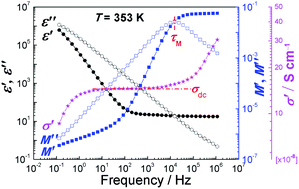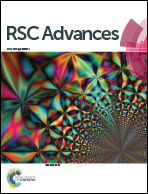Phase-dependent dielectric properties and proton conduction of neopentyl glycol
Abstract
Phase-dependent dielectric properties and proton conduction of neopentyl glycol (NPG), which is an organic molecular plastic crystal, were studied via variable-temperature broadband dielectric spectroscopy (BDS). Permittivity and conductivity data show the phase transformations of NPG from the crystalline state to the plastic crystalline state at 315 K and then to the molten state at 402 K across the temperature range of 293–413 K. The Vogel temperatures (Tv) fitted from the Vogel–Fulcher–Tammann (VFT) equation agree well with the values extrapolated by the Stickel plot (linearized Vogel plot). Impedance and modulus data display a separation of the −Z′′ (the imaginary part of the complex impedance) and M′′ (the imaginary part of the complex electric modulus) peaks in the crystalline phase. However, they overlap in both the plastic crystalline phase and the molten phase, indicating long-range proton conduction. In both the molten phase and the plastic crystalline phase, the temperature dependence of direct current conductivity (σdc) obeys the VFT equation very well. While the vehicle mechanism (translational diffusion) is an intrinsic mechanism for ionic or protonic conduction in the molten phase, it is speculated that the Grotthuss mechanism also works due to the self-dissociation of NPG molecules, which are similar to water molecules. In the plastic crystalline phase, the proton hopping mechanism is most likely the underlying ion-conducting mechanism because of the rotational disorder and intrinsic defects (vacancies) of the NPG molecules. In the ordered crystalline phase, the proton conduction is presumed to follow the proton hopping mechanism as determined from the localized relaxation and the temperature dependence of σdc (Arrhenius behavior).

- This article is part of the themed collection: Emerging Investigators Series


 Please wait while we load your content...
Please wait while we load your content...